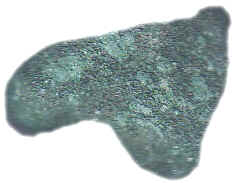|
ARKOSE
|
 |
A sandstone that consists of grains of quartz, feldspar and some mica cemented together by a mixture of clay and quartz minerals (perhaps calcium carbonate). It is a sedimentary rock formed from preexisting igneous and metamorphic rocks.
It's colour varies but it is often pink or grey. It has a similar appearance to granite although it's crystals are not so interlocked. It is coarse grained and found in strata of all geological periods.
It forms when granites and gneisses are eroded by weathering, transported and redeposited in rivers and lakes. Therefore it forms in layers and ripple marks are often evident.
It is used mainly as a building material and can be found in the Pennines (UK), California (USA), France and the Czech Republic.

|
ATACAMITE
|
 |
Atacamite forms by the evaporation of salt water from either salt lakes or land locked seas and is a member of the halide group. It is a secondary mineral and results due to the chemical alteration of preexisting copper compounds. It is copper from which it derives it's green colour. It can only exist in desert climates because it is dissolvable by rain water.
It is named after the Atacama Desert in Chile which is where it was first located and presently is only extracted from here. It is fairly soft on the mohs scale (3-3.5).
It may sometimes be seen in the vens of volcanos where it forms from gases released during eruptions.
Small deposits can be found in Australia, Bolivia and Arizona (USA).
